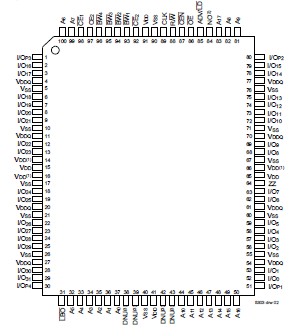Features: 256K x 36, 512K x 18 memory configurations
Supports high performance system speed - 150MHz (3.8ns Clock-to-Data Access)
ZBTTM Feature - No dead cycles between write and read cycles
Internally synchronized output buffer enable eliminates the need to control OE
Single R/W (READ/WRITE) control pin
Positive clock-edge triggered address, data, and control signal registers for fully pipelined applications
4-word burst capability (interleaved or linear)
Individual byte write (BW1 - BW4) control (May tie active)
Three chip enables for simple depth expansion
3.3V power supply (±5%)
2.5V I/O Supply (VDDQ)
Power down controlled by ZZ input
Packaged in a JEDEC standard 100-pin plastic thin quad and flatpack (TQFP), 119 ball grid array (BGA) and 165 fine pitch ball grid array (fBGA)
Pinout Specifications
Specifications
Symbol
|
Rating |
Commercial &
Industrial |
Unit |
| VTERM(2) |
Terminal Voltage with
Respect to GND |
-0.5 to +4.6 |
V |
| VTERM(3,6) |
Terminal Voltage with
Respect to GND
|
-0.5 to VDD |
V |
| VTERM(4,6) |
Terminal Voltage with
Respect to GND |
-0.5 to VDD +0.5 |
V |
| VTERM(5,6) |
Terminal Voltage with
Respect to GND |
-0.5 to VDDD +0.5 |
V |
| TA(7) |
Commercial
|
-0 to +70 |
|
| Industrial |
-40 to +85 |
|
| TBIAS |
Temperature
Under Bias
|
-55 to +125 |
|
| TSTG |
Storage
Temperature
|
-55 to +125 |
|
| PT |
Power Dissipation |
2.0 |
W |
| IOUT |
DC Output Current |
50 |
mA |
NOTES:
1. Stresses greater than those listed under ABSOLUTE MAXIMUM RATINGS may cause permanent damage to the device. This is a stress rating only and functional operation of the device at these or any other conditions above those indicated in the operational sections of this specification is not implied. Exposure to absolute maximum rating conditions for extended periods may affect reliability.
2. VDD terminals only.
3. VDDQ terminals only.
4. Input terminals only.
5. I/O terminals only.
6. This is a steady-state DC parameter that applies after the power supply has reached its nominal operating value. Power sequencing is not necessary;however, the voltage on any input or I/O pin cannot exceed VDDQ during power supply ramp up.
7. During production testing, the case temperature equals TA.
DescriptionThe IDT71V65802 are 3.3V high-speed 9,437,184-bit (9 Megabit) synchronous SRAMs. They are designed to eliminate dead bus cycles when turning the bus around between reads and writes, or writes and reads. Thus, they have been given the name ZBTTM, or Zero Bus Turnaround.
Address and control signals are applied to the SRAM during one clock cycle, and two cycles later the associated data cycle occurs, be it read or write.
The IDT71V65802 contain data I/O, address and control signal registers. Output enable is the only asynchronous signal and can be used to disable the outputs at any given time.
A Clock Enable (CEN) pin allows operation of the IDT71V65802 to be suspended as long as necessary. All synchronous inputs are ignored when (CEN) is high and the internal device registers will hold their previous values.
There are three chip enable pins (CE1, CE2, CE2) of the IDT71V65802 that allow the user to deselect the device when desired. If any one of these three are not asserted when ADV/LD is low, no new memory operation can be initiated.However, any pending data transfers (reads or writes) will be completed. The data bus will tri-state two cycles after chip is deselected or a write is initiated.
The IDT71V65802 have an on-chip burst counter. In the burst mode, the IDT71V65602/5802 can provide four cycles of data for a single address presented to the SRAM. The order of the burst sequence is defined by the LBO input pin. The LBO pin selects between linear and interleaved burst sequence. The ADV/LD signal is used to load a new external address (ADV/LD = LOW) or increment the internal burst counter (ADV/LD = HIGH).
The IDT71V65802 SRAM utilize IDT's latest high-performance CMOS process, and are packaged in a JEDEC Standard 14mm x 20mm 100-pin thin plastic quad flatpack (TQFP) as well as a 119 ball grid array (BGA) and a 165 fine pitch ball grid array (fBGA).

 IDT71V65802 Data Sheet
IDT71V65802 Data Sheet






